There are 4 main types of stretching that runners should do, but only at certain times. Some stretches can be dangerous when the muscles are cold so you need to make sure you understand your stretches, and we help you to do this below.
Running is classed as a high-impact sport as it places stress on the ankle, knee, hip joints, and spine. It also causes muscle shortening and tightening, especially if you run without opening your stride to work the muscles through a fuller range of motion.
Stretching is therefore essential but can seem like science in itself! We take a look at the four main types of stretches and help you understand their uses and benefits.
What Are The Four Different Types Of Stretches?
The four different types of stretches are:
- Dynamic
- Active (static stretching – added force applied by individual)
- Passive (static stretching – added force applied by assistant or device)
- PNF (Proprioceptive Neuromuscular Facilitation)
So what is the difference between these and what type of stretching should runners do? Here is a brief description of each type that will give you the tools to design your stretching routine.
Dynamic
A dynamic stretch requires momentum and movement. Repetitive movements for 10-30 seconds each. This type of stretch is when you move the muscles through a full range of motion that mimics the sport/activity you will be doing. It acts as a warm-up for the muscles by activating them and getting all the neurons firing to enhance blood flow, coordination, and power.
Advantage:
Least likely to cause a decrease in performance as long as you warm aerobically (walk/Run) for 5 to 10 minutes before stretching.
Active
An active stretch is similar to a dynamic stretch but without momentum. So you move into the stretch, hold it using the antagonist’s muscle, and then move back to the start. This is repeated 10-20 times. Again, this helps to not only fire up muscular reactions but also makes the muscles more flexible.
PNF
This type of stretch is usually performed with assistance from another person or you can use a resistance band in some instances. It involves both contraction and stretching of the muscles passively and actively, withholds in between. They can be quite painful but extremely beneficial and are commonly used by Physiotherapists and Sports Coaches to help with the rehabilitation of damaged muscles.
Passive
A passive stretch is when you are fully relaxed and not activating either the agonist or antagonist muscles to bring about the stretch. These are often done using an external force, either a prop or another person, to bring about the stretch. Think of a laying quad stretch – you would lay on your front and another person would bend your leg to bring about the quad stretch whilst you relax. Or you could use a towel or band.
What Stretches Is Beneficial To Runners?
All of the above types of stretches are beneficial to runners when used correctly. Stretches are essential for good flexibility, muscle condition, and reduced risk of injury.
What Types Of Stretches Should Runners Avoid?
Well, it’s not so much avoiding any type of stretch but more about making sure you utilize the right one at the right time. Some stretches need to be done before a run, and others should be done post-run.
When Should A Runner Never Stretch?
A runner should never do deep PNF stretches on cold muscles. This would overstretch the muscles causing microscopic tears and result in a painful run, poor performance, and possible injury.
Also, if you have pulled a muscle you should never stretch it unless you consult a physio or qualified coach first, as stretching already overstretched or torn muscles can be disastrous!
When Should A Runner Stretch?
Stretches should be done before and after a run, and sometimes even during if tightness and/or muscular pain are experienced.
Before a run, it is essential to get the circulation working well and to warm the muscles. Dynamic stretches are great for this as they increase blood flow whilst mimicking the movements and activating the muscles before starting the run. This can be followed by some active stretches for extra muscle activation.
Post-run is a great time to do those deep stretches, but gradually! Starting with some passive stretches you can build up to those more challenging PNF stretches for some real deep and restorative care.
What Are The Benefits Of Stretching Before A Run?
Stretching before a run will improve circulation and blood flow to the muscles. It also activates the neurons and helps with coordination, balance and therefore means better overall performance. It will also safeguard against muscle cramps and injuries. Also, the warm-up is sending signals to your brain that you are about to undertake exercise preparing your mind and body.
Do All Runners Stretch Before Running?
No – but they should! So many runners neglect their stretches and then wonder why things keep going wrong during their run. A lot of runners believe that a brief warm-up run is enough, but some of them don’t even do this – they just jump right in and start hitting it hard without doing either!
Will Stretching Degrade My Running Performance?
If you do the correct stretches at the correct times and with good technique, no, they will not degrade your running performance. They will only enhance it.
What Specific Stretches Are Best For Runners
Before stretching make sure that you warm up aerobically with at least 5 to 10 minutes of walking. You should never stretch when your body is cold (not warmed up) to prevent injury and/or decreases in performance before running. Some of the best stretches for runners to improve flexibility, posture and overall performance are:
Here are my go-to dynamic stretches that I perform prior to running. There are a countless number of dynamic stretches you can select from other than these:
(I do these dynamic stretches in this particular order – easier to more difficult)
- Later Leg Swings
- Walking Knee Hugs (Grabs)
- Butt Kicks
- Walking Frankensteins (use caution)
- Walking Lunges (use caution)
Pre-Run Stretches (Dynamic)
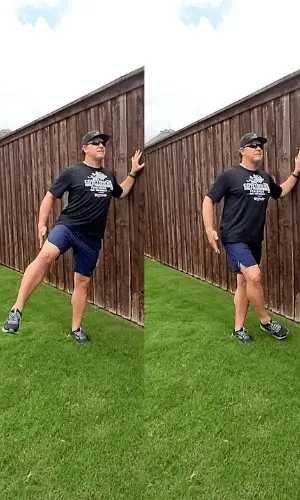
Lateral Leg Swings
Muscles Targeted: Calves, quadriceps, hamstrings, and groin muscle
When: Pre-Run
Type: Dynamic
- Start in a standing position. (you want to be near a wall for support otherwise you must have really good balance)
- One hand extended to the wall arms locked Back upright and straight with core muscles tight.
- Gently swing leg attempting to extend it to the full range of motion away from the wall – laterally (to the side).
- Bring your leg back across in the same plane of motion crossing in front of your stationary leg by about a foot or so.
- Repeat the leg swings 10-15 times
- Switch legs and repeat up to 3 times
Forward Leg Swings
Muscles Targeted: Calves, quadriceps, hamstrings, and groin muscle
When: Pre-Run
Type: Dynamic
- Start in a standing position with your body turned to the side of a wall, tree, or park bench. (you want to be near a wall for support otherwise you must have really good balance)
- One hand extended to the wall arms locked Back upright and straight with core muscles tight.
- Gently swing leg attempting to extend it to the full range of motion forward and backward parallel to the wall or park bench.
- Bring your leg back across in the same plane of motion crossing in front of your stationary leg.
- Repeat the leg swings 10-15 times
- Switch legs and repeat up to 3 times
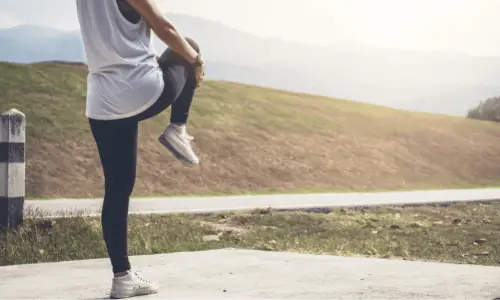
Walking Knee Hugs (Grabs)
Muscles Targeted: Quadriceps, calves, adductors, hamstrings, gluteus maximus, medius, and minimus
When: Pre-Run
Type: Dynamic
- Start in standing position feet should be shoulder-width apart
- Your core should remain tight and back straight
- Bring one knee tucked and up into your chest
- Grab your knee and pull it into your chest
- Hold for 30 seconds and slowly release your leg to the ground
- Switch legs and repeat up to 3 times

Butt Kicks
Muscles Targeted: Hamstrings and Glutes
When: Pre-Run
Type: Dynamic
- Start by standing tall
- One Heel off the ground towards your gluteus maximus (butt) and the opposite arm lifts towards your shoulder as if running
- Your thighs should remain straight pointing at the ground
- Switch sides – alternating back and forth for 30 – 60 seconds
Advanced: Switch back and forth quickly bringing yourself into a running stance while remaining in place almost kicking yourself in the glutes. Don’t overdo the kick – all you need is a gentle kick back towards the glutes.
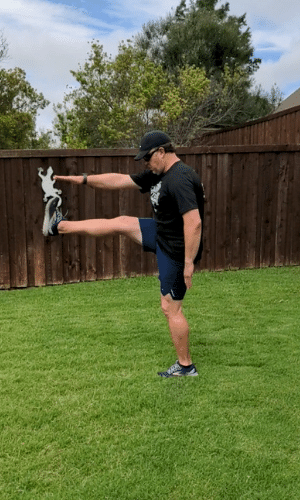
Straight Leg Kick (Frankensteins)
Muscles Targeted: Hips, quadriceps, and hamstrings
When: Pre-Run
Type: Dynamic
Use With Caution (older and less athletic runners)
- Start in a standing position
- Both arms should be extended straight out in front of you
- Keep your core (abs) tight while performing
- Raise one leg as high as you can in front of you keeping your forward leg locked
- Slowly move the same leg back down in front of you
- Raise your other leg as high as you can in front of you keeping your forward leg locked
- Slowly move the same leg back down in front of you
- Aim for 10-15 Frankensteins per leg
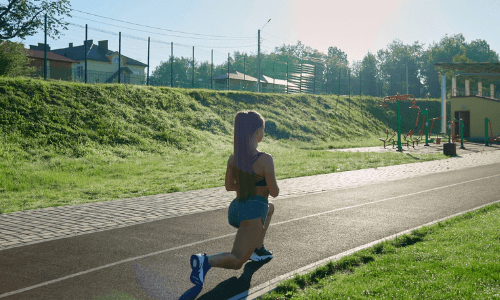
Walking Lunges
Muscles Targeted: Quadriceps, calves, adductors, hamstrings, gluteus maximus, medius, and minimus
When: Pre-Run
Type: Dynamic
Use With Caution (older and less athletic runners)
- Start in a standing position
- Step straight forward with one foot until your thigh and calf are at a 90-degree angle
- Your forward knee should not go beyond your forward toe
- Your rear leg/knee will come parallel to the ground almost touching
- Brings legs forward into a standing position and repeat on your other leg
- You may want to extend arms on both sides to balance or simply lunge in place.
- Repeat lunge 10-15 times on each leg
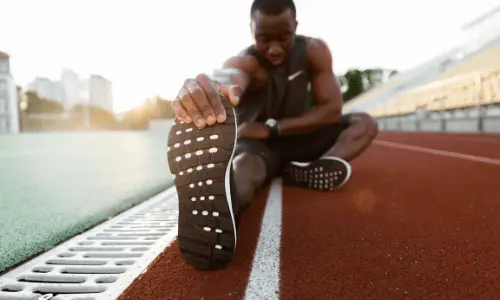

Post-Run Stretches (static)
Seated Hamstring Stretch
Muscles Targeted: Hamstrings
When: Post-Run
Type: Static
- Start in a seated position with one leg stretched out and heel touching the ground.
- Other foot should be resting on the ground
- The extended leg’s toes should be point straight up at the ceiling.
- Keeping your back straight, bend at the waist until you feel a stretch in the back of your thigh (hamstrings)
- Hold for 30 seconds and release.
- Switch legs and repeat up to 3 times
Advanced: With leg extended, stretch and try to grab your toes that are pointing at the ceiling
Ground Hamstring Stretch (long variation)

Standing Quad Stretch
Muscles Targeted: Quadriceps (upper front leg muscles)
When: Post-Run
Type: Static
- Start in a standing position. (you may want to be near a wall or railing for support)
- With one leg securely on the ground, lift your other legs towards your glutes and grab and hold your leg at the top part of your foot.
- The thigh of the leg that you are holding should be pointed straight down.
- Hold for 30 seconds and release.
- Switch legs and repeat up to 3 times
Advanced: Try not to hold on to anything for balance while performing the exercise
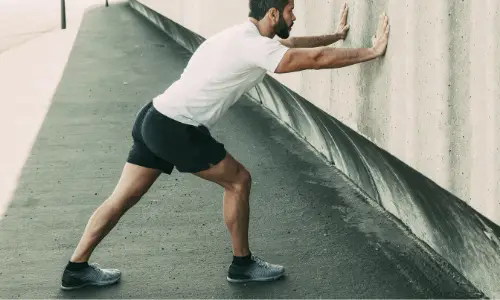
Standing Calf Stretch
Muscles Targeted: Calves
When: Post-Run
Type: Static
- Start in a standing position near a wall
- Lean forward and place both hands on the wall head should be upright starting at your hands.
- One leg should be forward closer to the wall stabilizing your body.
- Move the other leg back and extend your leg while keeping both feet on the ground
- Hold for 30 seconds and release.
- Switch legs and repeat up to 3 times
Here are some more static stretches you can perform post-run
Best Static stretches you can perform post-run
What Happens If You Don’t Stretch After Running?
If you don’t stretch properly after a run you will experience muscle tightening and shortening. You may also suffer cramps in the night – the dreaded calf or hamstring cramp is the worst!
Over prolonged periods, this can lead to an altered running gait which then has a knock-on effect that starts to negatively impact the joints.
What Types Of Stretching Are Best Before Running?
Dynamic and active stretches are best before a run. These get everything nicely fired-up and will have you rearing to go – and safely!
Should You Stretch If You Are Injured?
This really is dependent upon the type of injury. If you have pulled or torn a muscle then absolutely not until your physio or coach gives you the go-ahead. Generally, light stretches are good for us – either gentle passive stretches or light active stretches. But if you have an injury you should get advice on the best approach.
Related: Best Ankle Braces For Running With Peroneal Tendonitis
| Help support me and subscribe to my YouTube channel. YouTube video - 30 ways to make your runs less painful! Coach Scott's Credentials:
|
To sign up for a FREE half marathon training schedule, log sheet, and pace predictor CLICK HERE.

Recommended gear for runners
Connect with me:
| facebook.com/BeginnerToFinisher/ |
References
https://web.mit.edu/tkd/stretch/stretching_4.html
https://www.medicalnewstoday.com/articles/326799
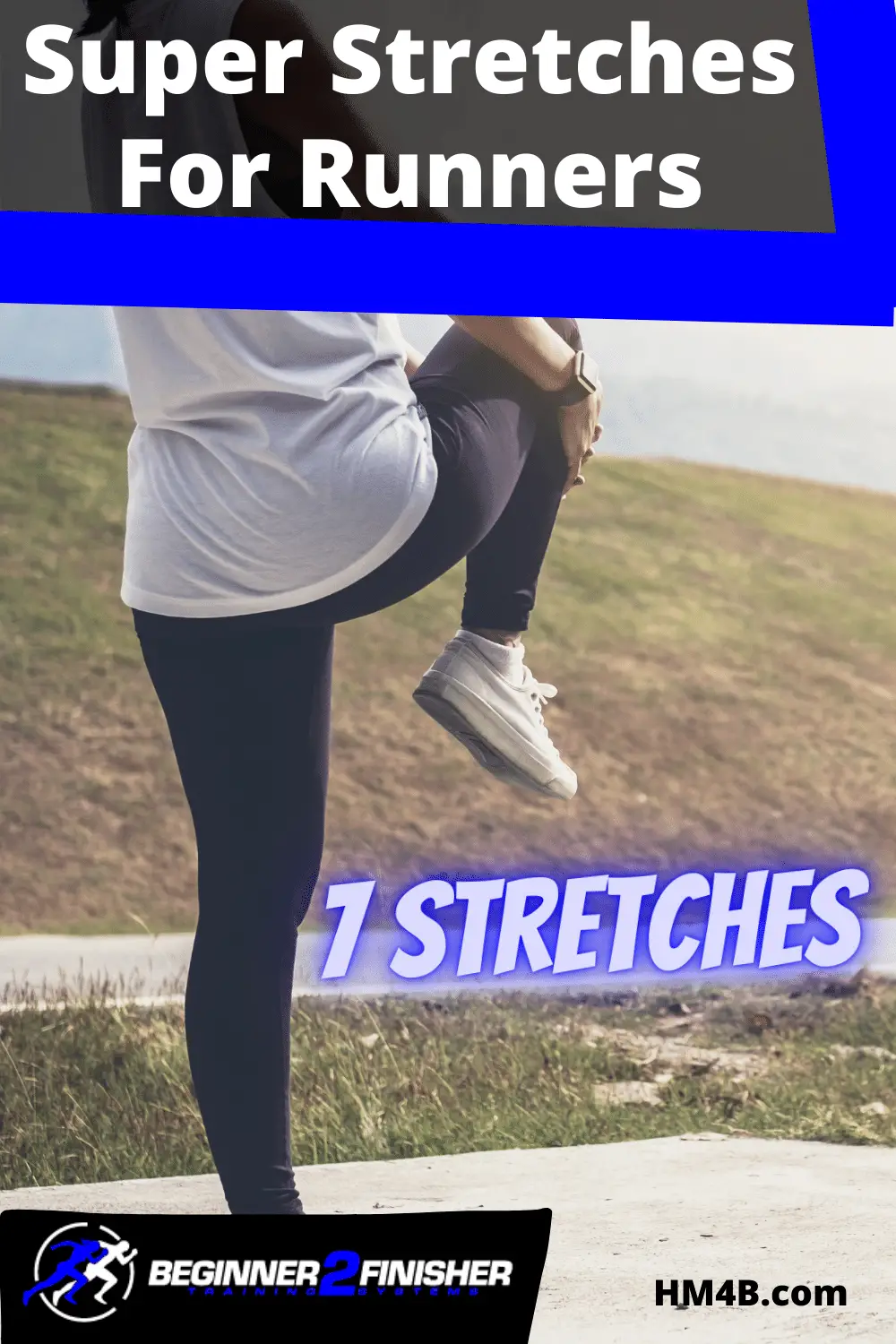
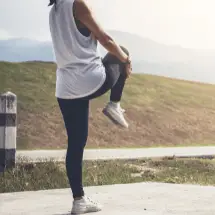
I have read so many posts about the blogger lovers however this post is really a good piece of writing, keep it up
Thank you for this post! I am not new to running and had run a few half marathons before – the last of which was 7 years ago! I hadn’t been running at all in the 6 weeks before I decided to sign up for a half marathon 4 weeks later which is why I turned to your plan. I only did 4 days a week but it got me back into shape just in time and I ended up finishing with a time far better than my last attempt. Thanks!
Thanks so much for your comment! My 4-week plan is meant for exactly what you used it for. Not really to compete but to get you back to where you stand a chance of completing your half marathon. Best of luck to you and your future races!